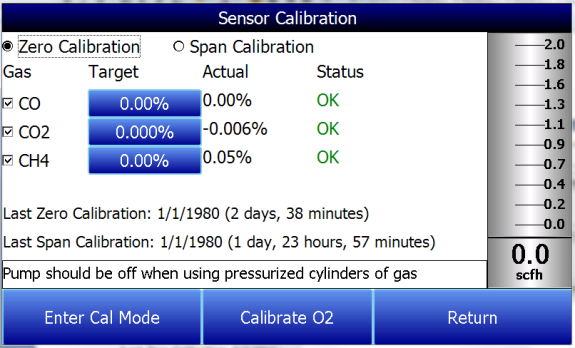Sensor Calibration
SSi Recommends the following user calibration schedule for the PGA3510:
|
If the device is used… |
Then perform a calibration… |
|
Daily |
Weekly |
|
Weekly |
Monthly |
|
Less than weekly |
Prior to use |
NOTE: This does not refer to SSi Factory Calibration. Factory Calibration should be performed annually, and is described in more detail here
.

Two types of calibrations can be performed on the NDIR sensor; Zero and Span. The Zero calibration should be performed with a gas that has none of the measured gases in it. Ideally this would be pure Nitrogen or Argon. The concentration of the Span calibration gas should closely resemble the gas that is being measured. For a heat treating application measuring endothermic gas, the ideal composition would be:
-
CO: 20%
-
CO2: 0.5%
-
CH4: 5.0%
-
H2: 40%
-
N2: Balance
Since the accuracy of the calibration gas directly influences the resulting accuracy of the instrument, the highest possible accuracy grade should be obtained. Some gas suppliers refer to this as a “Certified Primary Standard”. The high degree of accuracy is not required to obtain nominal values that exactly match the values shown above. The accuracy is required to know the exact composition of the gas in the cylinder. The actual composition will be shown on the bottle when it is delivered.
When flowing calibration gas is into the analyzer, turn the pump off. The amount of flow from the gas cylinder should be approximately 1.5 SCFH at no pressure. The gas cylinders will be under high pressure, so it is recommended that a two stage regulator with a low pressure secondary stage be used. It is good practice to begin the flow of gas before attaching the calibration gas to the instrument. This will prevent any high pressure bursts from entering the instrument.
Calibration gases can be obtained from Super Systems, however they can also be obtained from any supplier of custom gases.
Hydrogen Cell Note:
It is recommended that the instrument be turned on for three hours prior to performing an H2 calibration.